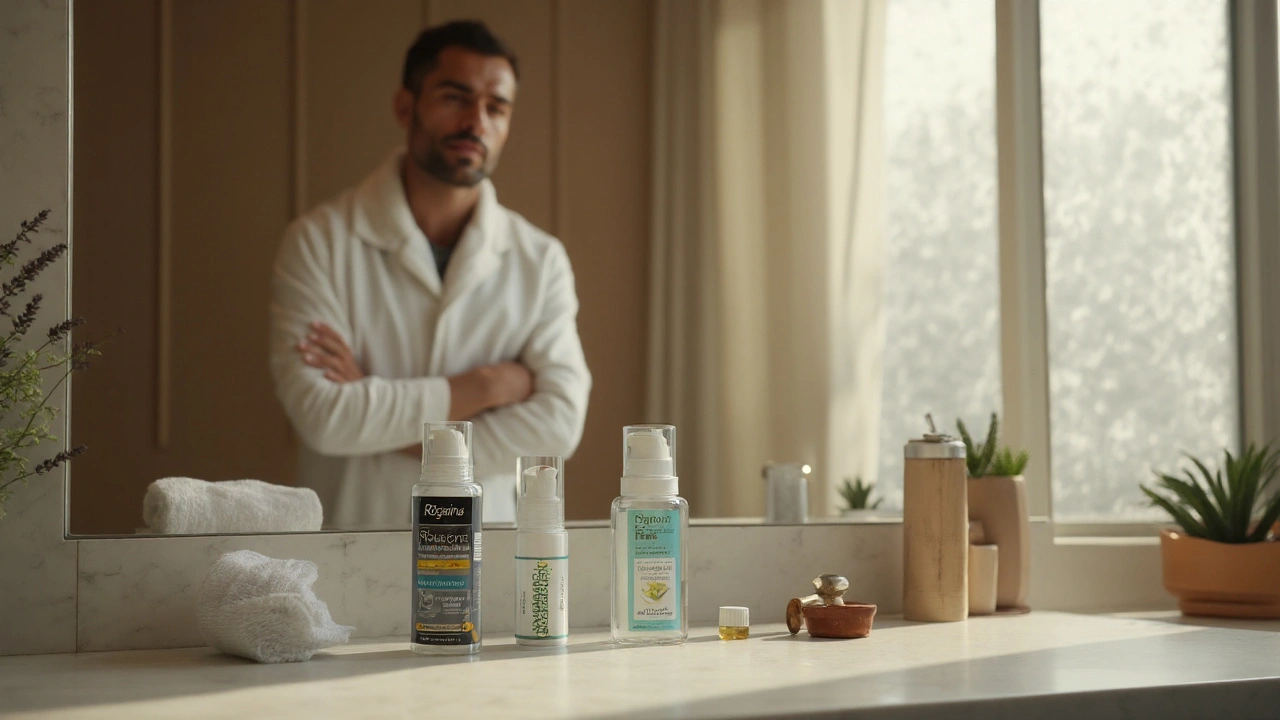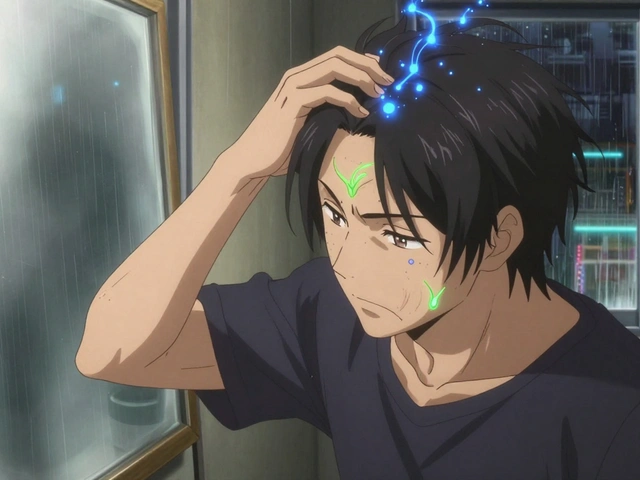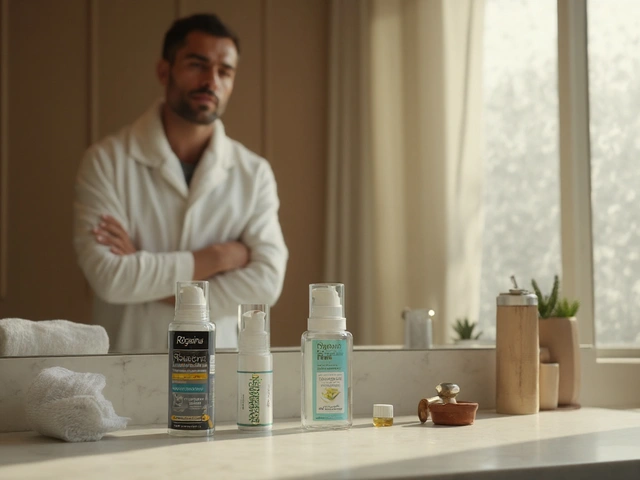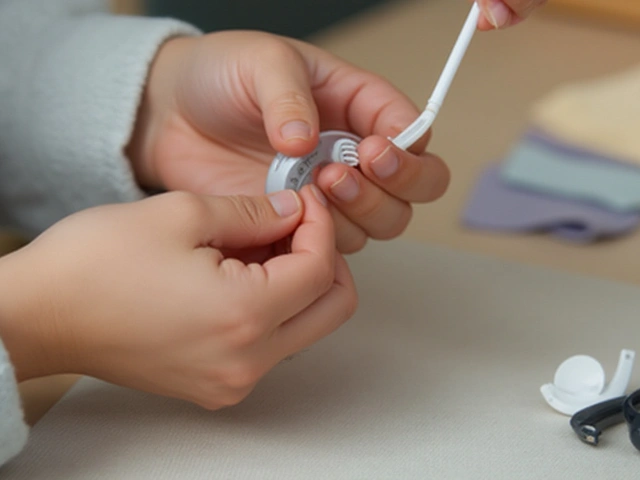Hair Loss Treatment Finder
Rogaine 2% minoxidil is a topical solution containing 2% minoxidil that stimulates hair follicles and slows thinning. It’s FDA‑approved for treating androgenetic alopecia in men and women. While the 2% formulation is the original over‑the‑counter option, many wonder if it holds up against newer or prescription‑only alternatives.
How Minoxidil Works at the Follicle Level
Minoxidil belongs to the class of vasodilators. When applied to the scalp, it widens blood vessels around hair follicles, improving oxygen and nutrient delivery. This triggers the hair growth cycle to shift from the resting (telogen) phase to the growth (anagen) phase, extending the length of each hair strand. Clinical trials show an average increase of 10-15% in hair count after four months of twice‑daily use.
Rogaine 2%: Formulation, Usage, and Real‑World Results
The 2% solution comes in a 60ml bottle with a dropper. Typical dosing is 1ml applied twice daily to the affected scalp areas. Users should apply to dry hair and wash hands afterward to avoid unwanted facial hair.
- Efficacy: Around 40% of users report visible regrowth, especially on the crown. Effect is modest on the frontal hairline.
- Side effects: Scalp itching, dryness, and occasional temporary shedding. Systemic absorption is negligible.
- Cost: Approx. $30USD for a month’s supply, making it one of the most affordable options.
Compliance is crucial. Missing applications for more than a few days can reverse gains within weeks.
Alternative #1: Oral Finasteride
Finasteride is a prescription pill that blocks the conversion of testosterone to dihydrotestosterone (DHT), the hormone primarily responsible for follicle miniaturization in androgenetic alopecia.
- Mechanism: Reduces scalp DHT by ~70%.
- Efficacy: 65-80% of men see at least a 15% increase in hair count after 12months.
- Side effects: Sexual dysfunction, mood changes, and rare post‑finasteride syndrome.
- Cost: $0.80‑$1.20 per day for generic versions.
Finasteride is FDA‑approved for men only; women of child‑bearing age must avoid it.
Alternative #2: Rogaine 5% Minoxidil (or Generic 5%)
5% minoxidil is a higher‑strength topical formulation that delivers double the active concentration of the 2% version.
- Efficacy: 60‑70% of users notice measurable regrowth, with better results on the vertex.
- Side effects: Slightly higher incidence of scalp irritation and hypertrichosis (unwanted hair growth on face/body).
- Cost: $40‑$45 for a 60ml bottle.
The 5% version is also over‑the‑counter for men, but women need a prescription in many jurisdictions.
Alternative #3: Low‑Level Laser Therapy (LLLT)
Low‑Level Laser Therapy is a non‑invasive light‑based treatment that stimulates cellular activity in hair follicles.
- Mechanism: Photobiomodulation enhances ATP production, promoting anagen phase.
- Efficacy: Clinical studies report 30‑45% improvement in hair density after 24weeks of thrice‑weekly sessions.
- Side effects: Generally none; rare reports of mild scalp warmth.
- Cost: Devices range from $200 (handheld comb) to $1500 (clinic‑based caps).
Compliance is easier-just a few minutes per session-but the upfront expense can be a barrier.

Alternative #4: Ketoconazole Shampoo
Ketoconazole shampoo is an antifungal wash that also reduces scalp inflammation and DHT locally.
- Mechanism: Inhibits fungal overgrowth and reduces cytokine‑mediated follicle damage.
- Efficacy: When used twice weekly, studies show a 10‑20% increase in hair shaft diameter.
- Side effects: Skin dryness, occasional itching.
- Cost: $15‑$25 for a 200ml bottle.
Ketoconazole works best as an adjunct to minoxidil or finasteride, not as a stand‑alone solution.
Alternative #5: Saw Palmetto (Oral Supplement)
Saw Palmetto is a plant extract believed to mildly inhibit 5‑alpha‑reductase, the enzyme that creates DHT.
- Efficacy: Limited trials suggest a modest 5‑10% improvement in hair density.
- Side effects: Gastrointestinal upset in some users; generally well‑tolerated.
- Cost: $20‑$35 for a month’s supply of capsules.
Because evidence is thin, many clinicians recommend it only for patients looking for a natural, low‑risk option.
Side‑by‑Side Comparison
| Attribute | Rogaine 2% Minoxidil | Finasteride (oral) | 5% Minoxidil | LLLT | Ketoconazole Shampoo | Saw Palmetto |
|---|---|---|---|---|---|---|
| Type | Topical | Oral | Topical | Light‑based device | Topical wash | Oral supplement |
| Primary Mechanism | Vasodilation → anagen promotion | DHT suppression | Higher‑dose vasodilation | Photobiomodulation | Anti‑fungal + local DHT reduction | Natural 5‑α‑reductase inhibition |
| FDA Status (US) | OTC (2%) | Prescription (men) | OTC (5%) | OTC devices / medical‑grade | OTC (2%) | Dietary supplement |
| Typical Cost/mo | $30 | $25‑$35 | $45 | $70‑$125 (device amortized) | $20 | $30 |
| Average Efficacy* | 40% notice regrowth | 65‑80% reduce shedding | 60‑70% notice regrowth | 30‑45% improve density | 10‑20% increase shaft diameter | 5‑10% modest gain |
| Common Side Effects | Scalp irritation, shedding | Sexual dysfunction, mood changes | Higher irritation, unwanted facial hair | None (rare warmth) | Dryness, itching | GI upset (rare) |
*Efficacy numbers reflect pooled data from peer‑reviewed trials up to 2024.
Choosing the Right Option for Your Situation
Not every treatment fits every person. Consider these decision points:
- Budget: If you need the cheapest daily regimen, the 2% solution wins.
- Gender: Women of child‑bearing age should avoid finasteride; a 2% or 5% minoxidil is safer.
- Hair‑line vs Crown: Minoxidil works best on the crown; finasteride tackles diffuse thinning, including the frontal area.
- Tolerance for pills: Some dislike daily oral medication; topical options avoid systemic exposure.
- Risk aversion: If sexual side effects are a deal‑breaker, stick with minoxidil or LLLT.
- Long‑term commitment: All options require ongoing use; stopping leads to reversal within months.
Many dermatologists recommend a combination-e.g., finasteride for systemic DHT control plus minoxidil for local follicle stimulation-delivering the highest overall success rates.
Practical Tips for Getting the Most out of Rogaine 2%
- Apply to a clean, dry scalp. Wait at least 30minutes before styling or using other products.
- Use the dropper to measure exactly 1ml; over‑application doesn’t speed results.
- Stick to twice‑daily dosing. If you miss a dose, apply at the next scheduled time-don’t double up.
- Combine with a gentle shampoo (e.g., a mild sulfate‑free formula) to reduce irritation.
- Monitor progress with monthly photos. Expect visible changes after 12‑16 weeks.
- If you experience persistent itching, try a lower‑concentration formulation for a week before returning to 2%.
Patience pays off. Hair cycles are slow; realistic expectations keep you motivated.
Related Concepts and Next Steps
Beyond the options listed, other pathways exist for stubborn hair loss:
- Hair transplant surgery: Redistributes healthy donor follicles to thinning zones-costly but permanent.
- Platelet‑rich plasma (PRP) therapy: Uses your own blood platelets to deliver growth factors directly to the scalp.
- Scalp microneedling: Small punctures trigger wound‑healing pathways that complement minoxidil.
Each of these belongs to the broader "advanced hair restoration" cluster, while the basics we covered sit in the "non‑prescription and low‑risk" tier. Readers who finish this guide often move on to deeper dives on surgical options or the science of the hair growth cycle.

Frequently Asked Questions
Can I use Rogaine 2% and finasteride together?
Yes. Combining a topical vasodilator (minoxidil) with a systemic DHT blocker (finasteride) targets hair loss from two angles and is the most common prescription for men with moderate to severe androgenetic alopecia. Always discuss dosing with a dermatologist.
Is the 2% solution effective for women?
Women typically see better results with the 5% formulation, but the 2% version is still FDA‑cleared for female use and carries a lower irritation risk. Many women start with 2% to gauge tolerance before moving up.
How long does it take to see results from Rogaine 2%?
Most users notice the first signs of reduced shedding within 2-3 months, but visible regrowth usually appears after 4-6 months of consistent use.
Are there any drug interactions with minoxidil?
Topical minoxidil has minimal systemic absorption, so interactions are rare. However, oral antihypertensives can sometimes enhance the mild blood‑pressure‑lowering effect of minoxidil, so inform your doctor if you’re on blood‑pressure medication.
What should I do if I experience scalp irritation?
First, reduce application frequency to once daily for a week, then resume twice daily. Switching to the foam formulation (if using solution) often eases irritation. If symptoms persist, stop use and consult a dermatologist.
Can natural supplements replace minoxidil?
Natural options like saw palmetto or biotin can support overall hair health, but they lack the robust clinical evidence that minoxidil provides. Most experts view them as adjuncts, not stand‑alone replacements.










Comments (14)
Selena Justin
September 25, 2025 AT 05:02 AMThank you for the thorough overview; the breakdown of each treatment’s mechanism really helps newcomers understand what they’re dealing with. I appreciate the clear distinction between topical and oral options, especially regarding gender considerations. The cost analysis is also spot‑on for anyone budgeting their regimen. Your inclusion of practical tips for Rogaine 2% usage will likely improve compliance for many readers. Overall, a very well‑structured guide.
Bernard Lingcod
September 30, 2025 AT 18:56 PMInteresting read! The side‑effect profiles listed make me think twice about jumping straight into finasteride. I also like the suggestion of combining ketoconazole shampoo with minoxidil for added benefit. The table is a nice quick reference. It’s good to see both low‑budget and high‑budget pathways covered. Definitely helpful for anyone starting their hair‑loss journey.
Raghav Suri
October 6, 2025 AT 08:49 AMFirst off, let me say that the article does a solid job of laying out the landscape, but there are a few nuances that deserve extra attention. While the 2% minoxidil is indeed affordable, its efficacy ceiling is limited, especially on the frontal hairline where vascularization differs from the crown. Studies have shown that the scalp’s blood flow in the vertex region responds more readily to vasodilators, which explains the higher success rates there. Moreover, users often report an initial shedding phase that can be mistaken for treatment failure, yet this is a normal telogen shift. It’s crucial to educate patients that this shedding can last up to six weeks and should not prompt premature discontinuation. On the topic of side effects, the article mentions scalp irritation but omits the fact that alcohol‑based solvents in some formulations can exacerbate dermatitis in sensitive individuals. Switching to a foam version can mitigate this issue, as the carrier is less irritating. Another point is the interaction with antihypertensive medications; although topical absorption is minimal, there have been anecdotal reports of additive blood‑pressure‑lowering effects. If you’re on beta‑blockers, monitoring is advisable. Regarding finasteride, the piece correctly flags sexual dysfunction, but it fails to mention the emerging data on persistent post‑finasteride syndrome, which, while rare, is a legitimate concern for long‑term users. For women, the article suggests the 5% formulation with caution, yet many dermatologists now prescribe the 2% version combined with topical anti‑androgens like spironolactone cream for synergistic effect. The inclusion of low‑level laser therapy is commendable, but efficacy data varies wildly between home devices and clinical caps, often due to differences in wavelength and power density. Users should verify that any device they purchase meets the FDA’s Class II clearance specifications. Lastly, the cost analysis could benefit from a per‑hair‑saved metric, helping patients calculate the true economic value of each regimen. Overall, the guide is a solid foundation, but adding these finer points would make it truly comprehensive.
Freddy Torres
October 11, 2025 AT 22:43 PMMinoxidil works best on the crown, plain and simple.
Andrew McKinnon
October 17, 2025 AT 12:37 PMOh great, another “budget‑friendly” potion that promises miracles while your wallet cries. The 2% formula is basically diluted hope, and the irritation risk? Just your scalp’s way of reminding you it’s not a spa day. If you’re looking for cutting‑edge, maybe try a “nanotech‑infused” serum that no one’s actually tested. In the world of hair loss, hype beats science every other Tuesday.
Dean Gill
October 23, 2025 AT 02:30 AMThe comparison table is a masterstroke, condensing a wealth of data into a digestible format that even a novice can parse without a PhD in dermatology. I particularly liked how the cost‑per‑month metric aligns with real‑world budgeting strategies, allowing readers to forecast long‑term financial commitments. Additionally, the inclusion of both pharmaceutical and device‑based solutions acknowledges the diverse preferences among patients, from pill‑averse individuals to tech enthusiasts. The article also wisely cautions about systemic absorption, which is often overlooked in over‑the‑counter discussions. By highlighting the synergy between finasteride and minoxidil, it gives a practical roadmap for combination therapy, which many clinicians recommend as first‑line for moderate to severe androgenetic alopecia. The practical tips section, with step‑by‑step application guidance, addresses the compliance gap that plagues many treatment plans. Moreover, the FAQ segment anticipates common concerns, reducing the need for readers to scour multiple sources for answers. Overall, the piece strikes a balance between scientific rigor and user‑friendly presentation, making it a valuable resource on the Reddit hair‑loss community.
Royberto Spencer
October 28, 2025 AT 16:24 PMOne must contemplate the very essence of “solution” when confronting follicular decline; it is not merely a chemical interaction but a dialogue between identity and societal expectation. To prescribe a regimen without addressing the psychological toll is to treat only the symptom, not the self. Thus, any discourse on minoxidil or finasteride should be accompanied by a reminder that confidence remains the most resilient hair of all.
Annette van Dijk-Leek
November 3, 2025 AT 06:18 AMWow!!! This guide is absolutely EVERYTHING!!! 🎉 The way you broke down each option had me nodding along the whole time!!! I love the practical tips for Rogaine 2%!!! Such clear, actionable advice makes this journey feel doable!!! Thank you for the thoroughness and the positivity!!!
Katherine M
November 8, 2025 AT 20:11 PMIndeed, the article presents a comprehensive synthesis of current hair‑loss therapeutics. 🌿 The balanced assessment of efficacy versus adverse‑event profiles is particularly commendable. 📊 It equips readers with the necessary data to make informed decisions tailored to their individual circumstances. ✨
Bernard Leach
November 14, 2025 AT 10:05 AMThe overview is solid concise and to the point.
Shelby Larson
November 19, 2025 AT 23:59 PMHonestly the cost breakdown hits the nail on the head – $30 a month for 2% minoxidil is cheap af. But don’t expect miracles on the front; it’s really a crown‑only champ. Also, the side‑effects list is spot on – itching and occasional shedding are par for the course. If you can’t tolerate that, maybe look at ketoconazole shampoo – it’s a decent add‑on.
felix rochas
November 25, 2025 AT 13:52 PMWhat a laughable oversimplification!!! They gloss over the serious risks of finasteride!!! Sexual dysfunction is not a “minor” side‑effect – it can ruin lives!!! And the “safe” 2% minoxidil? Don’t be fooled – the FDA’s “OTC” label is a marketing ploy!!! Do your own research!!!
inder kahlon
December 1, 2025 AT 03:46 AMThe guide nicely distinguishes between topical and oral therapies, making it easier to choose based on personal preference and medical history.
Dheeraj Mehta
December 6, 2025 AT 17:40 PMGreat summary! 😊 The practical tips for Rogaine application are especially useful. 👍